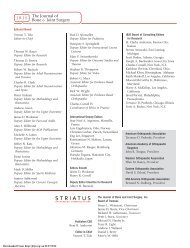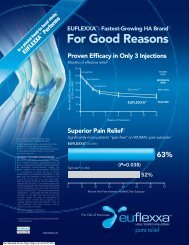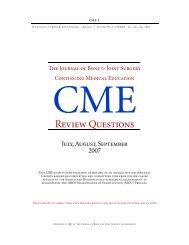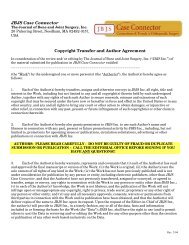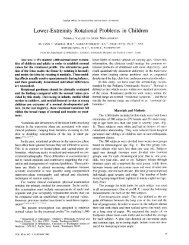Commentary and Perspective - The Journal of Bone & Joint Surgery
Commentary and Perspective - The Journal of Bone & Joint Surgery
Commentary and Perspective - The Journal of Bone & Joint Surgery
You also want an ePaper? Increase the reach of your titles
YUMPU automatically turns print PDFs into web optimized ePapers that Google loves.
e23(1)<br />
COPYRIGHT Ó 2010 BY THE JOURNAL OF BONE AND JOINT SURGERY, INCORPORATED<br />
<strong>Commentary</strong> <strong>and</strong> <strong>Perspective</strong><br />
<strong>Commentary</strong> on an Article by B.H. Currier, MChE, et al.: ‘‘In Vivo Oxidation in Remelted Highly Cross-Linked<br />
Retrievals’’<br />
By Jevan Furmanski, PhD, <strong>and</strong> Victor M. Goldberg, MD<br />
Total joint arthroplasty is a highly successful procedure; however, the one major issue that remains is wear <strong>of</strong> the bearing<br />
surfaces <strong>and</strong> the resultant adverse biological response to wear particles. Many studies <strong>of</strong> ultra-high molecular weight polyethylene<br />
have indicated that residual free radicals combined with oxygen result in increased brittleness <strong>and</strong> reduction <strong>of</strong><br />
mechanical properties. <strong>The</strong> development <strong>of</strong> highly cross-linked ultra-high molecular weight polyethylene with use <strong>of</strong> irradiation<br />
in inert environments, <strong>and</strong> subsequent free-radical stabilization by either annealing or remelting, provided a bearing<br />
surface with the potential for significant reduction <strong>of</strong> wear. <strong>The</strong>re have been several clinical studies that have confirmed, with<br />
use <strong>of</strong> radiographic techniques, this reduction in wear. However, in the recent radiographic study by Currier et al., an<br />
unexpected increase in wear was seen in this ultra-high molecular weight polyethylene after seven years in vivo. This troubling<br />
observation requires further study.<br />
Currier et al. investigated clinically retrieved components <strong>of</strong> several designs, manufactured from distinct formulations <strong>of</strong><br />
ultra-high molecular weight polyethylene, to provide additional data on their in vivo performance. Several important observations<br />
were made in both retrieved acetabular cups <strong>and</strong> retrieved tibial inserts. <strong>The</strong> range <strong>of</strong> radiation doses employed is <strong>of</strong> interest, as this<br />
essentially determines the extent <strong>of</strong> cross-linking <strong>and</strong> free-radical generation in the unstabilized material. It is notable that only<br />
one <strong>of</strong> twenty-six moderately irradiated (5-Mrad) ultra-high molecular weight polyethylene acetabular liners had an oxidation<br />
index <strong>of</strong> >0.1, while eight <strong>of</strong> twenty-four highly irradiated (>9-Mrad) acetabular liners were found to have a peak oxidation index<br />
<strong>of</strong> >0.1. <strong>The</strong> oxidation index results for the tibial components were more mixed for the various materials, with six <strong>of</strong> the nineteen<br />
components exhibiting an oxidation index <strong>of</strong> >0.1; however, nearly all <strong>of</strong> these had been moderately irradiated. <strong>The</strong>se initial results<br />
seem to indicate that, if there is a secondary mechanism for in vivo oxidation <strong>of</strong> ultra-high molecular weight polyethylene that does<br />
not depend on an initial population <strong>of</strong> free radicals, it could depend on the irradiation dose or the severity <strong>of</strong> mechanical loading<br />
experienced during patient use.<br />
While it is very interesting that substantial amounts <strong>of</strong> oxidation were observed in remelted ultra-high molecular weight<br />
polyethylene retrievals, the clinical relevance <strong>of</strong> marginal amounts <strong>of</strong> oxidation is not clear. <strong>The</strong> authors found the oxidation index<br />
to exceed 0.1 in fifteen <strong>of</strong> sixty-nine cases, <strong>and</strong> these cases had been in vivo approximately one to five years. To interpret the meaning<br />
<strong>of</strong> this level <strong>of</strong> oxidation, some context is needed to compare these levels <strong>of</strong> oxidation with those that have been observed to result in<br />
substantial material degradation <strong>and</strong> loss <strong>of</strong> mechanical integrity. <strong>The</strong> oxidation threshold, beyond which substantial <strong>and</strong> precipitous<br />
changes in mechanical strength <strong>and</strong> ductility are expected, is generally given as an oxidation index <strong>of</strong> >1. This threshold was<br />
clearly documented in tensile experiments on two radiation-sterilized conventional materials aged in air by Currier <strong>and</strong> associates 1<br />
in 2007. However, the mechanical <strong>and</strong> clinical consequences <strong>of</strong> marginal or subcritical oxidation are not well understood, <strong>and</strong> this is<br />
an area <strong>of</strong> active research. It is not known, for instance, if the critical amount <strong>of</strong> oxidation resulting in compromised structural<br />
performance is a function <strong>of</strong> cross-link density, which would directly impact the expected clinical performance <strong>of</strong> marginally<br />
oxidized cross-linked formulations. It st<strong>and</strong>s to reason that clinical oxidation performance is a function <strong>of</strong> the density <strong>of</strong> molecular<br />
entanglements between the crystalline lamellae, which is in turn modulated by cross-link density, heat treatment, <strong>and</strong> crystallinity.<br />
Currier et al. reported that the oxidation index correlated with the time for which the implant had been in the patient, but it is<br />
unknown whether the rate <strong>of</strong> oxidation accelerates or decelerates, particularly since the mechanism for oxidation in cross-linked<br />
<strong>and</strong> remelted ultra-high molecular weight polyethylene formulations is obscure. We agree with Currier et al. that further study is<br />
warranted to underst<strong>and</strong> the long-term oxidation <strong>of</strong> moderately <strong>and</strong> highly cross-linked <strong>and</strong> remelted ultra-high molecular weight<br />
polyethylene formulations, with attention to the effect <strong>of</strong> both marginal <strong>and</strong> severe oxidation on mechanical performance.<br />
Jevan Furmanski, PhD<br />
Department <strong>of</strong> Mechanical <strong>and</strong> Aerospace Engineering,<br />
Case Western Reserve University,<br />
Clevel<strong>and</strong>, Ohio<br />
J <strong>Bone</strong> <strong>Joint</strong> Surg Am. 2010;92:e23(1-2) d<br />
doi:10.2106/JBJS.J.00981<br />
Downloaded From: http://jbjs.org/ on 01/27/2014
NUMBER<br />
O<br />
e23(2)<br />
d<br />
T HE J OURNAL OF B ONE &JOINT SURGERY JBJS. ORG<br />
d d<br />
VOLUME 92-A 14 CTOBER 20, 2010<br />
COMMENTARY AND P ERSPECTIVE<br />
Victor M. Goldberg, MD*<br />
Department <strong>of</strong> Orthopaedics,<br />
Case Western Reserve University School <strong>of</strong> Medicine,<br />
Clevel<strong>and</strong>, Ohio<br />
*In support <strong>of</strong> their research for or preparation <strong>of</strong> this work, one or more <strong>of</strong> the authors received, in any one year, outside funding or grants <strong>of</strong> less than $10,000 from<br />
the National Institutes <strong>of</strong> Health. Neither they nor a member <strong>of</strong> their immediate families received payments or other benefits or a commitment or agreement to<br />
provide such benefits from a commercial entity.<br />
Reference<br />
1. Currier BH, Currier JH, Mayor MB, Lyford KA, Van Citters DW, Collier JP. In vivo oxidation <strong>of</strong> gamma-barrier-sterilized ultra-high-molecular-weight polyethylene bearings.<br />
J Arthroplasty. 2007;22:721-31.<br />
Downloaded From: http://jbjs.org/ on 01/27/2014




